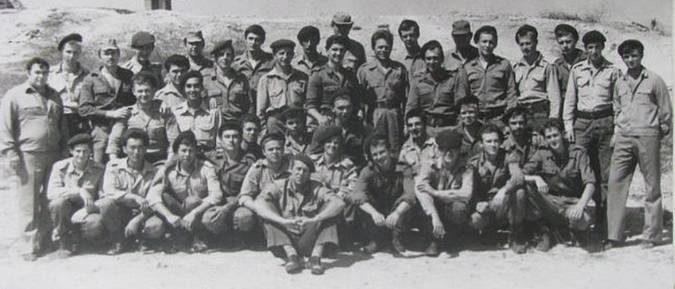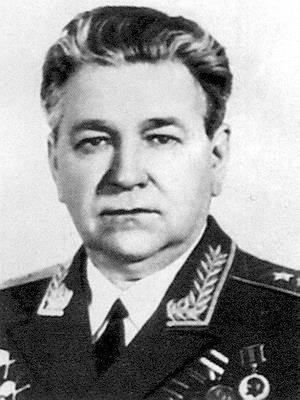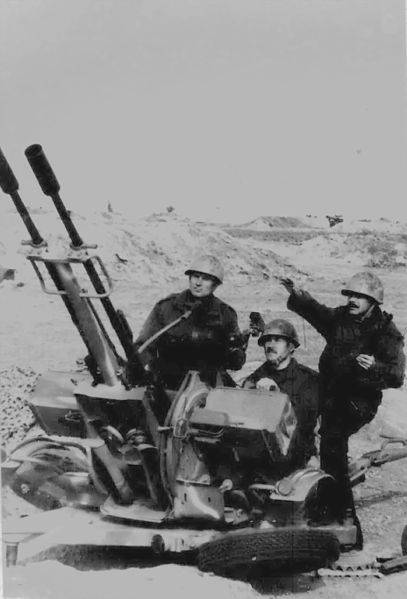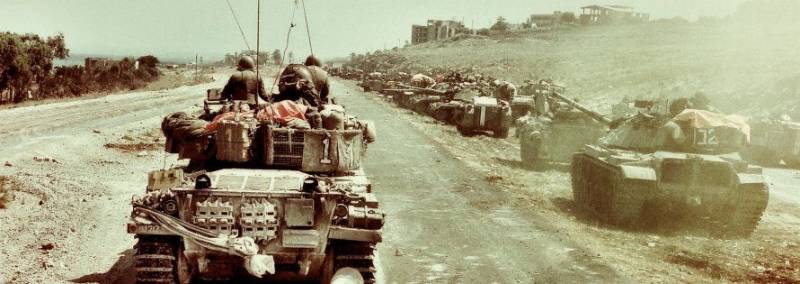Operation Caucasus-2. How Soviet air defense saved Syria
Why did Israel need to send troops to Lebanon? For several decades, the territory of Lebanon was actively used by various Palestinian military-political structures to house their bases, training centers, and also as a springboard for the commission of terrorist attacks against Israel. Almost all areas adjacent to the northern border of the State of Israel, to the beginning of the 1980-ies. controlled by the Palestine Liberation Organization. Since the PLO in those years received impressive Soviet military assistance, not only rifle units were concentrated along the border with Israel, but also anti-aircraft installations and long-range artillery.
However, the formal reason for the commencement of the military operation was an attempt on the Israeli ambassador to the UK, Shlomo Argov, on 3 on June 1982. As it turned out, he was organized and led by the militants of the Organization Abu Nidal (OAN) - one of the toughest and most radical Palestinian groups, which by that time had long separated from the PLO of Yasser Arafat. Shlomo Argov survived the assassination attempt, but remained paralyzed for the rest of his life and died in 2003 in the year from the effects of his injuries.
As early as June 4, the Israeli leadership approved a plan of aerial attack of Lebanese targets in response to an attempt on the life of the ambassador. On the same day, at about 15 p.m. a raid began aviation Israel to the western regions of the Lebanese capital Beirut. In response, the PLO began shelling Israeli territory with artillery pieces, and on June 6, 1982, Israeli forces crossed the Lebanese border. Thus began the war between Israel and the Palestine Liberation Organization. Direct support for the PLO in this war was provided by Syria, which by that time was a longtime ally of the USSR in the region. The Soviet Union was not only completely on the side of the Palestinians and Syria in terms of information, but also delivered to Syria weapon, ammunition, assisted in training the Syrian soldiers and PLO fighters. In addition, in Syria, a significant number of Soviet military specialists and instructors have been deployed regularly since 1956 on a regular basis.
Repeatedly, Soviet military specialists of various profiles had to take direct part in the hostilities of the Arab countries against Israel. Soviet military personnel stationed in Syria participated in the Six-Day War 1967 of the year, fighting in March-July of 1970, in the air war in the fall of 1972, in the Doomsday War of 6-24 of October 1973.
In peacetime, Soviet military specialists serviced the military equipment supplied to Syria, trained Syrian officers and soldiers. It should be noted that the Soviet officers went to Syria quite willingly, because, like in any other foreign business trip, they paid very well in Syria and our servicemen hoped to improve their financial situation, and just to visit another and very unusual country.
By the beginning of the Lebanese war 1982, the anti-aircraft missile brigade of a mixed composition, two anti-aircraft artillery regiments, two radio engineering battalions, and two electronic warfare battalions were concentrated in Syria. In addition, there were a large number of Soviet military advisers in the staff of the Syrian Ministry of Defense and in the formations and units of the Syrian army. When Israel launched an attack on Lebanese territory, Soviet military specialists had no choice but to fight as part of the Syrian units in which they served.
So, on July 20, 1982, in the area of the Beirut-Damascus road, Israeli troops landed. Israeli soldiers advanced to the control unit of the adviser to the commander of the forces in Lebanon, Major General Mikhail Petrovich Nosenko. The control unit included five Soviet and three Syrian officers and two crews of radio stations. Our and the Syrian military had no choice and they entered into battle with the Israeli paratroopers. Within an hour, the control cell repelled enemy attacks, until the Syrian arrived in time for help tank company. The battle killed the Soviet military sergeants N. Yumatov and V. Viktorov, two Syrian officers, and Major General Mikhail Nosenko was injured.

By the time Israel attacked Lebanon, an agreement on military assistance had been concluded between Moscow and Damascus. But the Soviet leadership did not immediately respond to such large-scale events. This was due to the fact that in the year 1982, the USSR already fought a three-year war in Afghanistan. In addition, within the Soviet leadership, the struggle for power was growing, since it was clear that Leonid Ilyich Brezhnev had only a little time left to die and the party leaders were discussing who could change him at the head of the party and the state.
However, in October 1982 of the year, shortly before Brezhnev's death, negotiations took place in Moscow between Syrian President Hafez Asad and Politburo member Yury Vladimirovich Andropov, who by this time actually played a major role in the Soviet party-state leadership. Of course, the Soviet leadership did not want to get involved in the open armed conflict in the Middle East in addition to the war in Afghanistan, but Moscow couldn’t respond to the beginning of the war in which IDF units in Syrian forces were also concentrated in Lebanon. As a result, the optimal way out of the situation was found - the Soviet Union announced the start of the holding of military exercises "Caucasus - 2".
As part of military exercises in January 1983, a 8-thousandth contingent of Soviet troops was transferred to Syria by sea, consisting of 2 anti-aircraft missile regiment C-200BE, rocket-technical base, helicopter and ground electronic warfare units. Sending personnel and military equipment originated from the port of Nikolaev. Given the specifics of the Syrian landscape, military equipment was repainted in the "desert colors". As for the personnel, he was transferred to Syria in the context of the strictest secrecy. All the servicemen were dressed in civilian clothes and passed off as tourists. The first 10 on January 1983 was the 220 th anti-aircraft missile regiment arrived in Nikolaev from the port of Tartus, and in February the 1983 th anti-aircraft missile regiment arrived in 231. Soviet servicemen were placed in special closed military camps, which were very well guarded by Syrian troops.
Parts of the EW were located in the Bekaa Valley and on the Golan Plateau. At the same time, Soviet troops were not brought into the territory of Lebanon, but a large number of Soviet military advisers were in the Syrian units operating in Lebanon. Anti-aircraft missile regiments were placed in Syria in the areas of Homs and Dumeirah, after which Israel banned the IDF Air Force from flying to 200-kilometer zones from the location of the Soviet air defense systems. Anti-aircraft missile regiments obeyed the commander of the Syrian Air Force and Air Defense - only he could give a direct order to use the C-200. However, the Western press at that time repeatedly wrote that the Soviet air defense systems were in fact not controlled by Damascus and were subject exclusively to the Soviet military command. The Soviet anti-aircraft gunners were assigned the task of protecting the airspace of Syria from Israeli air raids.
However, in September 1983, the Soviet air defense forces still shot down one Israeli E-2С Howkeye long-range radar detection aircraft. Three months later, the Israeli military intelligence, in a sign of revenge for the death of the aircraft, launched a sabotage action against the Soviet anti-aircraft missile regiment. At night, Israeli saboteurs launched an attack on the regimental location, but the attack was repulsed by a Syrian unit that ensured the safety of the Soviet military. As a result, none of the Soviet soldiers was injured, and the attack was successfully repulsed.
The presence of Soviet air defense systems in Syria played a very important role in deterring Israel. First, the C-200 complex at that time was one of the most “advanced” and efficient in the world. He had a range of 180 km and more and was able to destroy enemy planes still on the approach to the airspace of Syria. Secondly, since the C-200 complexes in Syria were served by Soviet military experts, this hampered the Israeli command and did not allow it to strike at the locations of the Soviet units - in Tel Aviv did not want the war with the PLO and Syria to turn into a confrontation with powerful soviet union.

Moscow approached the organization of command and control of the troops deployed in Syria with the utmost responsibility. To coordinate their actions, two operational groups were created. The first group was located at the Main Command of the USSR Air Defense Forces in Moscow, led by Colonel-General Aviation Boris Viktorovich Bochkov (1924-1991, pictured) - Deputy Commander-in-Chief of the Air Defense Forces (Commander in Chief of those years was Alexander Marshall Ivanovich Koldunov).
The second task force was constantly in Damascus, led by Lieutenant-General Konstantin Stepanovich Babenko (1922-2011). The link between the operational commands was carried out by Lieutenant-General Volter Makarovich Kraskovsky (1931-2008) - the first deputy chief of the General Staff of the country's Air Defense Forces. Highly qualified specialists — generals and officers of the Soviet air defense with extensive service experience — including participants in the Great Patriotic War (such as General Bochkov and General Babenko) worked in both operational groups.
17 May 1983 Israel and Lebanon signed an agreement on withdrawing troops and ending the state of war, but there was no end to the armed confrontation in Lebanon. To oversee the withdrawal of Palestinian forces in Lebanon, units of the Multinational Peacekeeping Force disembarked, the backbone of which was the NATO troops of the American, French and several other armies.
 In December, the US, British, French, and Italian naval forces 1983 launched a blockade on the coast of Lebanon to eliminate the possibility of supporting the Shiite and Druze forces operating in the country, supplied by Syria. Artillery of the NATO ships began to fire at the positions of the Shiite and Druze formations and the Syrian troops defending the Beirut-Damascus highway. In November, 1983, American aircraft struck Syrian positions in the Bekaa Valley. In response, the Syrian army also attacked the US Navy grouping. 4 December 1983 of the year Soviet air defense shot down attack aircraft A-7 Corsair II and A-6 Intruder. For the first time in ten years since the Vietnam War, the US Navy carrier-based fighter-bombers suffered combat losses.
In December, the US, British, French, and Italian naval forces 1983 launched a blockade on the coast of Lebanon to eliminate the possibility of supporting the Shiite and Druze forces operating in the country, supplied by Syria. Artillery of the NATO ships began to fire at the positions of the Shiite and Druze formations and the Syrian troops defending the Beirut-Damascus highway. In November, 1983, American aircraft struck Syrian positions in the Bekaa Valley. In response, the Syrian army also attacked the US Navy grouping. 4 December 1983 of the year Soviet air defense shot down attack aircraft A-7 Corsair II and A-6 Intruder. For the first time in ten years since the Vietnam War, the US Navy carrier-based fighter-bombers suffered combat losses. Active hostilities lasted six days, during which the Soviet air defense shot down American 9, Israeli 4 and French 2 aircraft. In addition, another 4 aircraft Israel lost in aerial combat with Syrian aircraft. Thus, the Soviet anti-aircraft regiments coped well with the tasks assigned to them to protect the airspace of Syria and prevented the very real threat of more large-scale raids and shelling of Syrian territory by Israeli aircraft.
By the beginning of 1984, fighting in the vicinity of Beirut was resumed, and international peacekeeping forces were withdrawn from the Lebanese capital. This circumstance became decisive in the further fate of the Soviet military contingent in Syria. In July, 1984, the Soviet troops were withdrawn from the country and returned to the Soviet Union. However, military advisers and specialists continued to work as part of the Syrian military units and divisions, in military schools of Syria.
For many decades, Soviet and Russian servicemen have made a huge contribution to the defense and security of the Syrian state. Many lives were given by our country in Syria. Only during the Lebanese war 1982-1983, according to official data, were 15 Soviet soldiers killed, and about 200 people were injured of varying degrees of severity. Now, of course, the loss of Russian troops in Syria, given the duration of hostilities and their scope, is much more significant.

Information